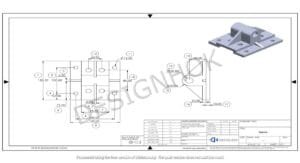Understanding Mechanical Design The Backbone of Engineering
Mechanical Design is a crucial part of engineering that plays a vital role in the creation and development of machines, tools, and systems. It is a process that involves designing components, systems, and processes to ensure that they function efficiently, safely, and reliably. Mechanical design touches almost every aspect of our daily lives, from the cars we drive to the appliances we use at home, and even the complex machinery that powers industries. But what exactly is Mechanical Design, and why is it so important?
What is Mechanical Design Made Simple?
Mechanical Design Made Simple is the process of designing parts, components, and systems of a mechanical nature. It combines principles of physics, material science, and engineering to create functional and efficient products. The primary goal is to transform an idea or a need into a tangible product or system that performs a specific function.
This process involves several stages, including conceptualization, analysis, prototyping, testing, and production. Mechanical Design Made Simple use various tools and software, such as CAD (Computer-Aided Design), to create detailed drawings and models of their designs. These models are then analyzed for factors like strength, durability, and efficiency to ensure they meet the required specifications.
Key Elements of Mechanical Design
Phosfluorescently incubate market-driven networks and synergistic e-services. Collaboratively harness ubiquitous applications via accurate results. Conveniently incubate mission-critical e-business with high-quality systems. Interactively provide access to open-source e-business without compelling e-markets. Intrinsically visualize user-centric meta-services after vertical e-business
- Conceptual Design: The first step in Mechanical Design is conceptualization. This is where ideas are generated and initial sketches or models are created. The designer considers the purpose of the product, its functionality, and how it will be used. This stage often involves brainstorming, research, and feasibility studies to determine the best approach for the design.
- Material Selection: Choosing the right materials is critical in Mechanical Design. The materials must be strong enough to withstand the stresses and forces the component will encounter, yet also be cost-effective and suitable for manufacturing. Factors like weight, durability, corrosion resistance, and thermal properties are considered when selecting materials.
- Design Analysis: Once a concept is developed, it must be analyzed to ensure it will work as intended. This involves calculating the forces, stresses, and other factors that will affect the component or system. Designers use mathematical models and simulations to predict how the design will perform under various conditions. This stage helps identify potential issues and allows for modifications before the design is finalized.
- Prototyping: Prototyping is a crucial step in Mechanical Design. A prototype is a physical model of the design that is built to test its functionality and performance. Prototypes can be made using various methods, including 3D printing, machining, or handcrafting. Testing the prototype helps identify any flaws or areas for improvement, which can then be addressed before mass production.
- Production and Testing: After refining the prototype, the design is prepared for production. This involves creating detailed manufacturing drawings and specifications. The production process may include machining, molding, casting, or assembling components. Once the product is manufactured, it undergoes rigorous testing to ensure it meets all the necessary standards and performs as expected.

Importance of Mechanical Design
Mechanical Design Made Simple is essential because it is the foundation of all Mechanical Design systems and devices. Without careful design, machines would not function properly, leading to inefficiencies, breakdowns, and even safety hazards. Well-designed mechanical systems are reliable, efficient, and cost-effective, which is critical for both manufacturers and consumers.
Moreover, Mechanical Design Made Simple is not just about making something work; it’s also about making it work better. Engineers constantly strive to improve designs, making products lighter, stronger, more efficient, and easier to manufacture. These improvements can lead to significant cost savings, better performance, and increased longevity of products.

The Future of Mechanical Design Made Simple
As technology continues to advance, so does the field of Mechanical Design. Innovations like additive manufacturing (3D printing), advanced materials, and artificial intelligence are transforming how Mechanical Design are created and implemented. Designers now have more tools and resources at their disposal than ever before, enabling them to push the boundaries of what is possible.
Mechanical Design is a fundamental aspect of engineering that is essential for creating functional, efficient, and reliable products and systems. It involves a complex process of conceptualization, analysis, prototyping, and production, with the goal of transforming ideas into tangible, working products. As technology evolves, the field of Mechanical Design will continue to play a critical role in shaping the future of engineering and manufacturing.

Conclusion
Mechanical Design Made Simple is the heart of engineering, driving the creation and innovation of machines and systems that power our world. From the initial concept to the final product, mechanical design involves careful planning, analysis, and testing to ensure that every component functions efficiently and reliably. Its importance cannot be overstated, as it lays the groundwork for the performance, safety, and longevity of countless products and systems we rely on daily. As technology continues to advance, Mechanical Design Made Simple will remain a critical field, shaping the future of engineering and enabling new possibilities in industries worldwide.
FAQ: Mechanical Design
1. What is mechanical design?
Mechanical Design is the process of creating parts and systems, like machines or tools, to make sure they work well and safely.
2. Why is mechanical design important?
It’s important because good design helps machines work efficiently, reduces the chance of problems, and keeps costs down.
3. What are the steps in mechanical design?
The steps include coming up with ideas, choosing materials, testing designs, building a model (prototype), and then making the final product.
4. What tools do designers use?
Designers often use CAD software to create detailed models and drawings of their designs.
5. What is prototyping?
Prototyping is making a sample of the design to test it. It helps find and fix any issues before full production.





